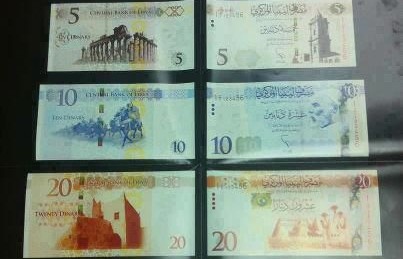25 August, 2013
A Banknote’s Other Role – New Libyan Series Reflects Political Change
As we pointed out in a recent issue of Currency News, banknotes are more than just units of exchange. They fulfill other roles too, including a psychological role in promoting the values of the country they represent. In this context, an important but often overlooked job of a banknote can be to confirm in the minds of the population the identity of who is – or rather, who is no longer – running the country. This is certainly true of those countries where the current political leader features on the banknotes and where, following regime change, one of the first actions of the new leaders is to remove all symbols of the previous administration and its leadership.
So it is with Libya, where – following the overthrow of long-time ruler Muammar al-Gaddafi in 2011 – the new administration regarded replacing his portrait on the country’s banknotes as an economic and political necessity, particularly in a country devastated by war.
Robust Tender Process
The changes were not immediate however, given that, between the end of the revolution in October 2011 and August 2012, Libya was ruled by the Transitional National Council. The first free elections were held in July last year, and power was handed to the new General National Congress in August. Shortly thereafter, plans were finalised for the new series and, following what the Governor of the Central Bank of Libya, H.E. Saddek Omar Elkaber, described as a ‘robust tender process’, the design and print contract was awarded to De La Rue last December. Within less than three months, the first of the new series of notes was introduced into circulation.
De La Rue has historically specialised in urgent banknote design and delivery at times of momentous political change, as it did after the break-up of the Soviet Union and the emergence of the CIS in 1991 and, more recently, with the new series in Iraq in 2004 following the overthrow of Saddam Hussein.
According to Mr Elkaber, ‘following the revolution in 2011 it was essential to replace the existing banknote series to reflect a new start for the country. We conducted an international open tender and due to their wealth of experience and track record of performance, we were very pleased to award the contract to De La Rue. We are delighted with the banknotes and very grateful that De La Rue was able to deliver them in such a short timescale.’
Politically Symbolic
In a politically symbolic move, the first in the new series, the 1 Dinar (L1), was launched on February 17, the second anniversary of the revolution, and replaces the version that featured an image of the ousted ruler. The front of the new note depicts a cheering crowd waving revolutionary flags, while the back features the Libyan flag and doves. Security features include a holographic windowed security thread and an embedded thread.
Next came the L20, issued on March 31. Predominantly orange in colour, it shows a traditional house in the oasis town of Ghadames on the back and Al-Ateeq mosque in Oujlah on the front. The main security features are a holographic stripe, a SPARK® Orbital™ patch, and a ColourShift thread on the reverse.
The latest in the series to be issued was the L50, on June 13, The new note is green in colour, and the image on the front of the previous version of Ghaddafi has been replaced with one of the 1922 lighthouse in Benghazi. The back features the rock arch in Tadrart Acacus, a mountain range renowned for its prehistoric rock art and a UNESCO World Heritage site. Like the L20, this note also features a holographic stripe. It also includes SPARK Orbital on the front and a windowed Motion® security thread with crescent and star images on the reverse.
All the notes are on paper with Cornerstone® – a watermark feature that strengthens the corners of the banknote – and all feature a watermark of Omar El Mukhtar (also known as the Lion of the Desert, and a freedom fighter when Libya was under Italian occupation who was captured and executed in 1931). The mould-made watermark is accompanied by an electrotype of the denomination numeral. The notes also include a feature for the blind and visually-impaired in the form of raised intaglio dots – one for the L1, two for the L5 and so on, up to five for the L50. There is also an iridescent band on all denominations.
Still to be issued are the L10 and L5 notes, both of which have already been modified following the regime change. The changes included the removal of the word ‘Jamahiriya’ from both notes (Jamahiriya being Ghaddafi’s terms for his own brand of democracy without political parties) and the inclusion of English in addition to Arabic text. The L5, meanwhile, saw the removal of the falcon crest from the image of the monument to the Battle of Al-Hani, again another symbol of the Ghaddafi era.
The Bank has not stated when the new versions of both notes will be issued. In the meantime, the previous version of the L50 has already been withdrawn from circulation while, according to the Bank, the old L1 and L20 notes will be withdrawn soon.
The Bank is also planning to change the design of Libya’s coins, and late last year issued a tender notice for new half and quarter Dinars as well as 100 and 50 Dirhams.










